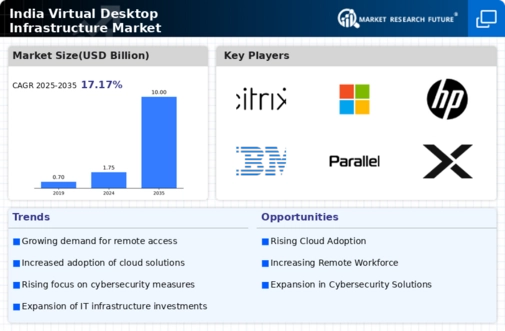Integration with Mobile and IoT Devices
The integration of mobile and Internet of Things (IoT) devices is emerging as a key driver for the virtual desktop-infrastructure market in India. As mobile device usage continues to rise, organizations are seeking solutions that allow seamless access to desktop environments from various devices. This trend is supported by data indicating that over 50% of Indian employees use mobile devices for work-related tasks. Virtual desktop infrastructure enables users to access their desktops securely from smartphones and tablets, thereby enhancing flexibility and productivity. Furthermore, the proliferation of IoT devices in various sectors necessitates a robust infrastructure that can support diverse endpoints. Consequently, the virtual desktop-infrastructure market is poised for growth as businesses adapt to the increasing demand for mobile and IoT integration.
Growing Demand for Remote Work Solutions
The virtual desktop infrastructure market in India is witnessing a significant increase in demand for remote work solutions. As organizations increasingly adopt flexible work arrangements, the need for secure and efficient remote access to desktop environments becomes paramount. This trend is reflected in a report indicating that approximately 70% of Indian companies are investing in remote work technologies. The virtual desktop-infrastructure market provides a robust framework for enabling employees to access their work environments from various locations, thereby enhancing productivity and collaboration. Furthermore, the ability to centralize data management and reduce hardware costs makes this solution appealing to businesses of all sizes. As the workforce continues to evolve, the virtual desktop-infrastructure market is likely to play a crucial role in shaping the future of work in India.
Cost Efficiency and Resource Optimization
Cost efficiency is a significant driver for the virtual desktop-infrastructure market in India. Organizations are increasingly seeking ways to optimize their IT budgets while maintaining high levels of performance and security. By leveraging virtual desktop infrastructure, companies can reduce hardware expenditures and minimize maintenance costs. A study suggests that businesses can save up to 30% on IT costs by transitioning to virtual desktop solutions. This cost-effectiveness is particularly appealing to small and medium-sized enterprises (SMEs) that may have limited resources. Additionally, the ability to scale resources according to demand allows organizations to allocate their budgets more effectively. As a result, the virtual desktop-infrastructure market is positioned to grow as more companies recognize the financial benefits of adopting these solutions.
Enhanced Data Security and Compliance Needs
In the context of increasing cyber threats, The virtual desktop infrastructure market in India is driven by a heightened focus on data security and compliance. Organizations are compelled to protect sensitive information and adhere to regulatory requirements, which necessitates robust security measures. Virtual desktop infrastructure offers centralized data management, reducing the risk of data breaches and ensuring compliance with industry standards. Reports indicate that nearly 60% of Indian enterprises prioritize security when selecting IT solutions. This emphasis on security not only safeguards organizational data but also enhances customer trust. As businesses navigate the complexities of data protection regulations, the virtual desktop-infrastructure market is likely to see sustained growth as a reliable solution for secure data access and management.
Support for Digital Transformation Initiatives
The virtual desktop-infrastructure market in India is significantly influenced by the ongoing digital transformation initiatives across various industries. Organizations are increasingly adopting digital technologies to enhance operational efficiency and customer experiences. Virtual desktop infrastructure plays a pivotal role in this transformation by providing a scalable and flexible IT environment that supports innovative applications and services. A survey indicates that approximately 65% of Indian businesses are prioritizing digital transformation, which includes the adoption of virtual desktop solutions. This alignment with digital strategies not only streamlines operations but also fosters a culture of innovation. As companies continue to invest in digital capabilities, the virtual desktop-infrastructure market is likely to expand, driven by the need for agile and responsive IT solutions.

















Leave a Comment